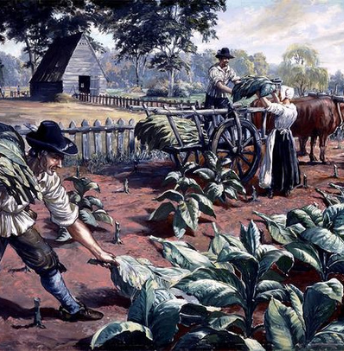
Tobacco Growing in Early America
Share
Early sixteen hundred America saw most farmers growing a few acres of tobacco to be used to barter with at market for goods they could not grow or produce themselves. However, the great demand from overseas encouraged the creation of huge plantations that eventually used indentured servants or slave labor to deliver this new commodity to market. When not clearing the land, the laborers spent a third of the year attending to the crops.

The ritual consisted of several steps. February was the usual time for preparing beds for the seedlings. The ground was hoed, thinned with sand and covered with pine bough to protect the new growths. Once the seeds burgeoned, the seedlings were culled to about four inches apart. These nascent plants had to then be protected from pestilence, such as the flea beetle, inclement weather or drought, which were constant worries. As May rolls around the arduous task of preparing the fields began. Small knee-high hills are made from dug up soil every three to four feet. These mounds are left until rains softens the soil that prepares them for planting the seedlings.

Once the plant reaches a couple of feet tall the weekly routine of removing weeds and abating pests is lessened. Next, the plants must be trimmed at both the top and bottom in order to stop flowering and prime the plant for leaf growth. Once the plant has achieved three to four feet in height, the remaining leaves are molly coddled and pampered by removing any extraneous growths and clipping shoots that would emerge and detract from leaf size. The plant at full maturity will stand between six and nine feet in height in late August or early September.

The true mark of success lay in the capacity of the crop master whose duty is to predict the perfect time for harvesting. The knowledge passed down from master to apprentice becomes cumulative and the art of the yield more refined. An experienced planter would recognize the optimal time to collect the leaves by using the color, size, odor, texture and pliability of the leaves to make a final judgement. The plants are then cut between ground and bottom leaves and sometimes left to wilt several hours on the ground in order to plump up before being cured.

Early tobacco farmers devised simple methods to cure the wilted leaves out of doors. This was soon replaced with dedicated sheds that permitted a more controlled drying process where the leaves were hung on lines between posts. Curing lasted anywhere between four and six weeks waiting for the yellowish green of the leaf to turn a golden brown. The next step is to strike the leaves. This means to lay them on the ground of the structure and allow them to sweat. Only when the tobacco was at a perfect degree of moisture could it be allowed to proceed to sorting.

Separating into groups according to quality was the next step in the manufacturing of a product that could be sold to an overseas market. The bundles were wrapped in hands, bunches of five to fourteen leaves depending on size. The hands were returned to palettes to sweat a second time. A final inspection was performed before releasing the goods for export. This was an arduous, time-consuming ritual that was well worth the efforts and helped to encourage development of the new colonies. To find out more about the financial impact of tobacco, you can read more here. Keep the toils of our ancestors in mind the next time you take a pinch. Happy snuffing.
